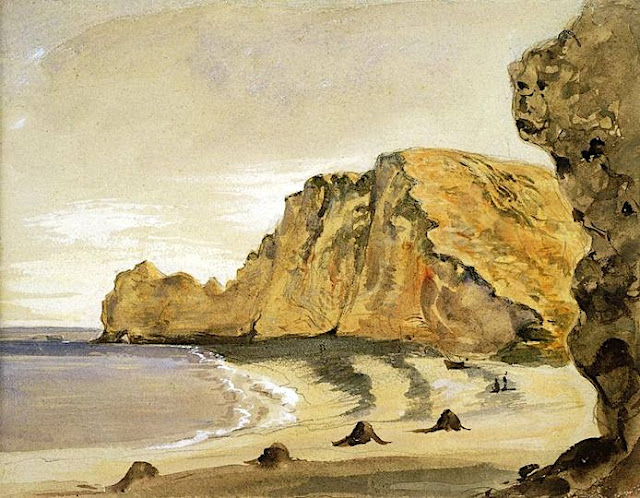GUSTAVE COURBET, (1819-1877 )
Les Petites Dalles (30 à 50m )
France
In Paysage Côtier, 1866, Huile sur toile, Leopold Museum, Vienne
Les Falaises
Les Petites Dalles (30 à 50m) sont des falaises situées dans un hameau entre Sassetot-le-Mauconduit et Saint-Martin-aux-Buneaux, en Haute-Normandie, France. Station balnéaire au sud de Dieppe en Normandie, sur la côte de la Manche et du pays de Caux, les falaises des Petites Dalles sont célèbres principalement parce qu'elles ont inspiré les peintres impressionnistes comme Claude Monet et Berthe Morisot. Elles sont également célèbres pour leurs nombreuses villas balnéaires construites à la fin du XIXème siècle et préservées (Les Catelets, Les Lampottes, Les Mouettes...)
L'ancien nom des Petites Dalles apparaît sous la forme latinisée Daletis dans une charte de 1252. C'est le diminutif de Dalis qui apparaît dans la même charte. Dalis devient Les Grandes-Dalles et Daletis, Les Petites Dalles. Le lieu devient définitivement à la mode en 1875 lorsque l'Impératrice d'Autriche, Elisabeth, dite Sissi, passa les mois d'août et de septembre au château de Sassetot-le-Mauconduit et se baigna régulièrement sur la plage des Petites Dalles. Le peintre Paul Valantin réalisa un tableau de la scène. Le 25 août 2016, un glissement de terrain sur une centaine de mètres de falaise s'est abattu. Près de 50 000 m3 de rochers se sont effondrés sur la plage de Saint-Martin-aux-Buneaux au lieu-dit Les Petites Dalles, selon le Service d'incendie et de secours de Seine-Maritime.
Le peintre
Jean Désiré Gustave Courbet était un peintre français initiateur du mouvement réaliste dans la peinture française du 19e siècle. Engagé à peindre uniquement ce qu’il pouvait voir, il rejetait les conventions académiques et le romantisme de la génération précédente. Son indépendance a constitué un exemple important pour des artistes tels que les impressionnistes et les cubistes.
Les peintures de Courbet de la fin des années 1840 et du début des années 1850 lui valent sa première reconnaissance. Elles ont défié les conventions en représentant des paysans et des ouvriers non idéalisés, souvent dans de grands formats, traditionnellement réservée aux peintures de sujets religieux ou historiques. Les peintures ultérieures de Courbet étaient pour la plupart d'un caractère moins ouvertement politique : paysages, marines, scènes de chasse, nus et natures mortes. Il fut emprisonné pendant six mois en 1871 pour son implication dans la Commune de Paris et vécut en exil en Suisse de 1873 jusqu'à sa mort.
Courbet a peint quelques montagnes dans sa vie : les montagnes du Jura autour d'Ornans (France), les falaises de Picardie et quelques montagnes en Suisse lors de son exil. Comme beaucoup de peintres du 19e siècle, Courbet souvent ne nomment pas les montagnes qu'il peints ; il aimait donner une description de l'atmosphère générale plutôt qu'une situation géographique précise.
"J'ai cinquante ans et j'ai toujours vécu libre; laissez-moi finir ma vie libre; quand je serai mort, qu'on dise de moi ceci: 'Il n'appartenait à aucune école, à aucune église, à aucune institution, à aucune académie. , encore moins à tout régime autre que le régime de la liberté. »
_______________________________________________________
2024 - Gravir les montagnes en peinture
Un blog de Francis Rousseau

%20Extraite%20du%20portfolio%20%22Naples%22%20%20e%CC%81dition%20limite%CC%81e%20a%CC%80%20300%20ex%20Editeur%20:%20Compagnie%20de%20Saint-Gobain,%20Paris,%201959%20%2037,5%20x%2028%20cm%20%20%20.png)
-'Le-ruisseau-de-la-Bre%CC%82me'-(1865)-muse%CC%81e-des-Beaux-Arts-de-Besanc%CC%A7on.jpg)


,%20Le%20Train%20de%20vagues%20a%CC%80%20la%20pointe%20des%20Poulains,%20huile%20sur%20toile%20signe%CC%81e%20et%20date%CC%81e%201991,%20marque%CC%81e%20du%20cachet%20Maurice%20Garnier%20et%20annote%CC%81e%20%C2%ABMG%C2%BB,%2081%20x%20116%20cm.%20Drouot,%202%20juin%202015.%20Aguttes%20OVV..png)
.jpg)








